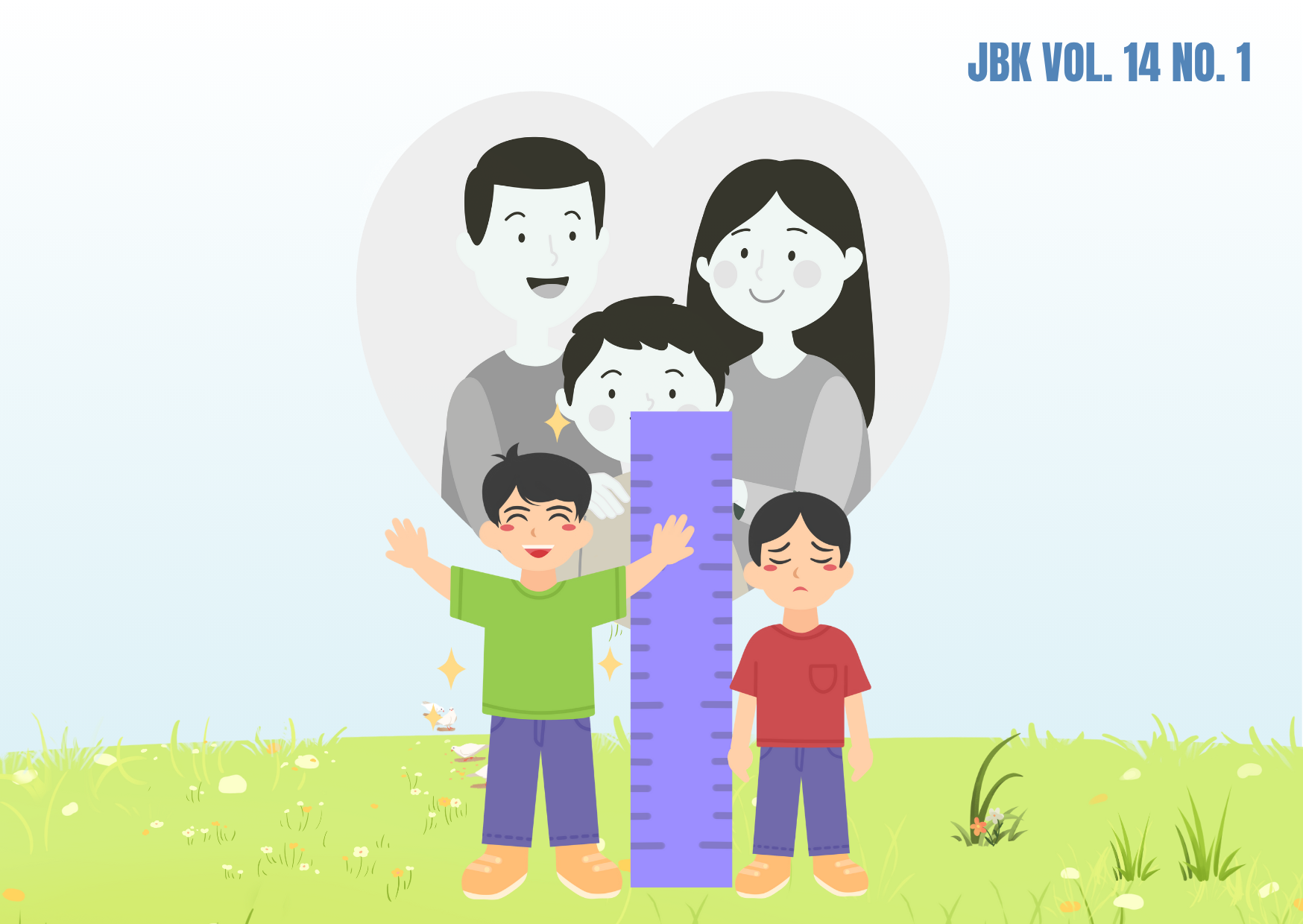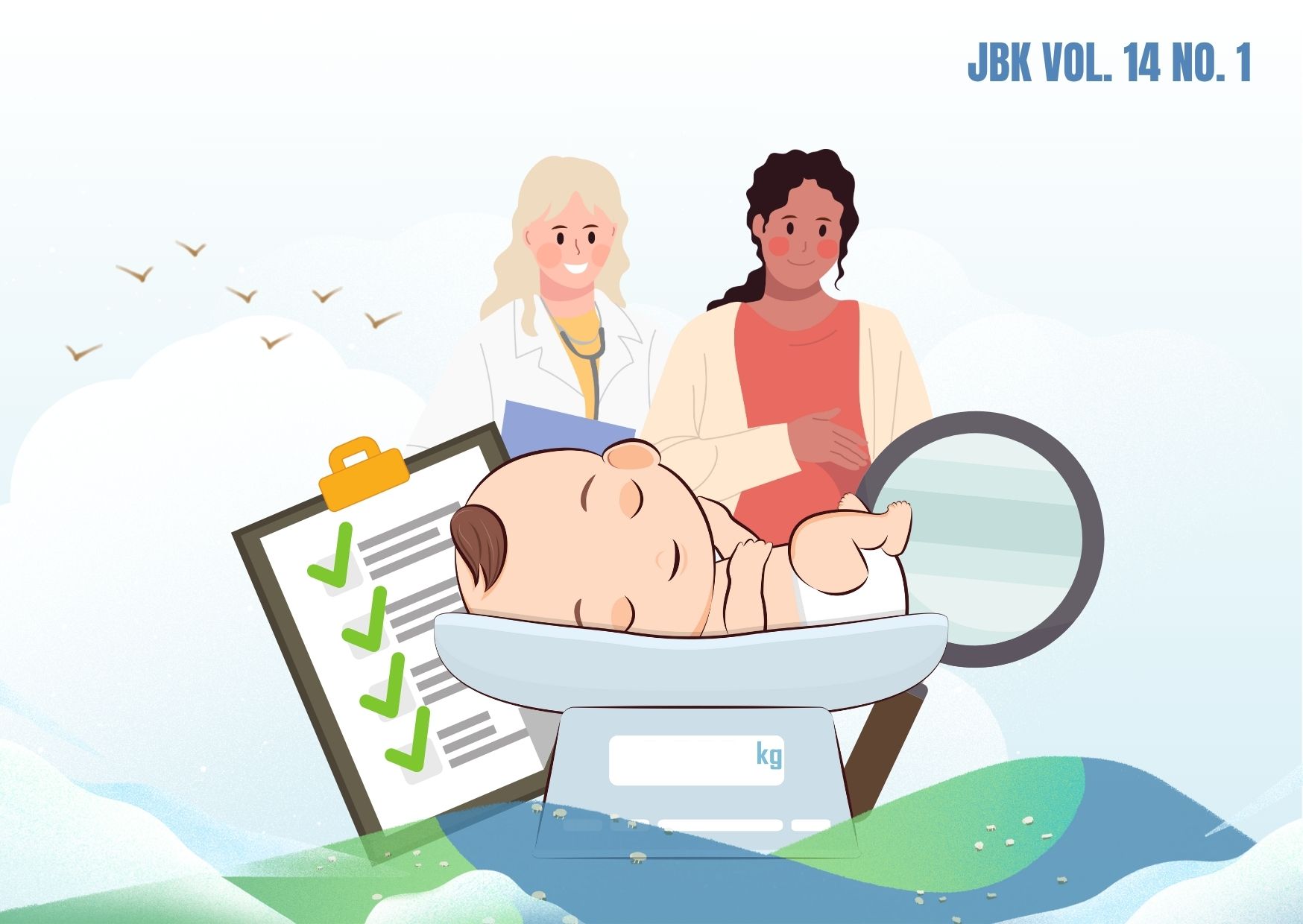CERVICAL CANCER SCREENING AND ASSOCIATED FACTORS AMONG WOMEN OF REPRODUCTIVE AGE IN LHOKSEUMAWE, ACEH
Downloads
Cervical cancer is the second most prevalent cause of cancer-related mortality among women worldwide. Indonesia has the second-highest incidence of cervical cancer worldwide. The etiology of cervical cancer in women is multifactorial. This study aimed to investigate the Pap smear screening tests and analyze the risk factors associated with cervical cancer in women of reproductive age in Lhokseumawe, Aceh, Indonesia. This quantitative study used a cross-sectional design. The data source comprised secondary data collected between January and September 2023 at a clinical laboratory in Lhokseumawe, Aceh, Indonesia. The study sample consisted of 100 women who underwent the Pap smear test. The independent variables examined were age, age at first childbirth, age at menarche, parity, menstrual cycle, history of contraceptive use, and history of miscarriage, whereas the dependent variable was the Pap smear test results. Chi-square analysis demonstrated significant correlations between miscarriage history (p=0.05), parity (p=0.001), menstrual cycle duration (p=0.049), and Pap smear cytological results. Logistic regression revealed that women with a previous miscarriage, more than two children, and menstrual cycles exceeding 28 days were 3.46, 1.32, and 2.53 times more likely, respectively, to have abnormal Pap smear results. Therefore, high-risk women should undergo regular cervical cancer screening to detect the precancerous lesions.
World Health Organization (WHO). Reproductive Health in the South-East Asia Region [Internet]. 2019 [cited 2024 Apr 26]. Available from: https://www.who.int/southeastasia/health-topics/reproductive-health
Global Cancer Observatory. Global Cancer Observatory [Internet]. 2022 [cited 2024 Jan 19]. Available from: https://gco.iarc.fr/en
East Java Provincial Health Office. Health Profile of East Java Province in 2019 [Internet]. 2019. Available from: https://dinkes.jatimprov.go.id/userfile/dokumen/Profil Kesehatan Jatim 2019.pdf
American Cancer Society. Signs and Symptoms of Cervical Cancer [Internet]. 2024 [cited 2024 Nov 20]. Available from: https://www.cancer.org/cancer/types/cervical-cancer/detection-diagnosis-staging/signs-symptoms.html
Gitonga E, Iseme R, Mutisya R, Kodhiambo M. Cervical Cancer Knowledge, Awareness and Related Health Behaviours Amongst Women of Reproductive Age in Kiambu County, Kenya: a Cross-sectional Study. Heal Psychol Behav Med [Internet]. 2022 Dec 31;10(1):1056–70. Available from: https://doi.org/10.1080/21642850.2022.2136184
Riani EN, Ambarwati D. Early Detection Kanker Serviks Sebagai Upaya Peningkatan Derajat Hidup Perempuan. SELAPARANG J Pengabdi Masy Berkemajuan [Internet]. 2020;3(2):144–6. Available from: https://doi.org/10.31764/jpmb.v3i2.1883
Nathasya Karren Zeta NKZ, Oktarlina RZ, Ramdini DA, Wardhana MF. Relationship Between Parity and Cervical Cancer: Literature Review. Med Prof J Lampung [Internet]. 2023 Apr 11;13(4 SE-):490–4. Available from: https://journalofmedula.com/index.php/medula/article/view/739
Analysa A, Lestari DPO, Artha IGA. Overexpression of PDL-1 is a Risk Factor for Lymph Node Metastasis in Cervical Cancer. Int J Heal & Med Sci [Internet]. 2023 Apr 12;6(2 SE-):69–76. Available from: https://doi.org/10.21744/ijhms.v6n2.2104
Robbers GML, Bennett LR, Spagnoletti BRM, Wilopo SA. Facilitators and Barriers for the Delivery and Uptake of Cervical Cancer Screening in Indonesia: a Scoping Review. Glob Health Action [Internet]. 2021 Jan 1;14(1):1979280. Available from: https://doi.org/10.1080/16549716.2021.1979280
Agustiansyah P, Sanif R, Nurmaini S, Irfannuddin, Legiran. Epidemiology and Risk Factors for Cervical Cancer. Biosci Med J Biomed Transl Res [Internet]. 2021;5(7):624–31. Available from: https://doi.org/10.32539/bsm.v5i7.326
Canfell K. Towards the Global Elimination of Cervical Cancer. Papillomavirus Res [Internet]. 2019;8:100170. Available from: https://www.sciencedirect.com/science/article/pii/S2405852119300369
Setiawan D, Andrijono, Hadinegoro SR, Meyta H, Sitohang RV, Tandy G, et al. Cervical Cancer Prevention in Indonesia: an Updated Clinical Impact, Cost-effectiveness and Budget Impact Analysis. PLoS One [Internet]. 2020 Mar 23;15(3):e0230359. Available from: https://doi.org/10.1371/journal.pone.0230359
Sumarmi S, Hsu YY, Cheng YM, Lee SH. Factors Associated With the Intention to Undergo Pap Smear Testing in the Rural Areas of Indonesia: a Health Belief Model. Reprod Health [Internet]. 2021;18(1):138. Available from: https://doi.org/10.1186/s12978-021-01188-7
Febrianti R, Wahidin M. Faktor – Faktor yang Mempengaruhi Pemeriksaan Pap Smear Pada Wanita Usia Subur di Poliklinik Kebidanan Rumah Sakit Umum Daerah H. Abdul Manap Kota Jambi. Bunda Edu-Midwifery J [Internet]. 2020 Feb 29;3(1 SE-Articles):1–10. Available from: https://bemj.e-journal.id/BEMJ/article/view/17
Latifah L, Nurachmah E, Hiryadi H. Faktor yang Berkontribusi Terhadap Motivasi Menjalani Pemeriksaan Pap Smear Pasien Kanker Serviks di Poli Kandungan. J Keperawatan Suaka Insa [Internet]. 2020 Jun 11;5(1 SE-Articles):90–9. Available from: https://journal.stikessuakainsan.ac.id/index.php/jksi/article/view/192
Endriani T, Budiana I, Mahendra INB, Surya I. Karakteristik Hasil Pap Smear Menurut Bethesda Di RSUP Sanglah Denpasar Tahun 2016-2017. E-Jurnal Med Udayana [Internet]. 2021 Jan 28;10:77. Available from: https://doi.org/10.24843/MU.2021.V10.i1.P14
Marcus JZ, Cason P, Downs LSJ, Einstein MH, Flowers L. The ASCCP Cervical Cancer Screening Task Force Endorsement and Opinion on the American Cancer Society Updated Cervical Cancer Screening Guidelines. J Low Genit Tract Dis [Internet]. 2021;25(3). Available from: https://journals.lww.com/jlgtd/fulltext/2021/07000/the_asccp_cervical_cancer_screening_task_force.1.aspx
Okunade KS. Human Papillomavirus and Cervical Cancer. J Obstet Gynaecol (Lahore) [Internet]. 2020 Jul 3;40(5):602–8. Available from: https://doi.org/10.1080/01443615.2019.1634030
Wulan RN. Cervical Cancer in Women of Childbearing Age. J Appl Transintegration Paradig [Internet]. 2022;2(2):71–84. Available from: https://e-journal.lp2m.uinjambi.ac.id/ojp/index.php/jatp/article/view/1425
Yuliawati Y, Martini M, Widiyanti S. Correlations Between the Age of First Married, Contraception Use and Family History With Cervical Precancer in Women of Childbearing Age at Metro City Health Center. Sci Midwifery [Internet]. 2022;10(2):1124–9. Available from: https://doi.org/10.35335/midwifery.v10i2.467
Anastasiou E, McCarthy KJ, Gollub EL, Ralph L, van de Wijgert JHHM, Jones HE. The Relationship Between Hormonal Contraception and Cervical Dysplasia/cancer Controlling for Human Papillomavirus Infection: a Systematic Review. Contraception [Internet]. 2022;107:1–9. Available from: https://www.sciencedirect.com/science/article/pii/S0010782421004455
Roura E, Travier N, Waterboer T, de Sanjosé S, Bosch FX, Pawlita M, et al. The Influence of Hormonal Factors on the Risk of Developing Cervical Cancer and Pre-Cancer: Results from the EPIC Cohort. PLoS One [Internet]. 2016 Jan 25;11(1):e0147029. Available from: https://doi.org/10.1371/journal.pone.0147029
Sara Gul Razia Bibi, Sadia Hanif, Sanila Gul, Komal Farooqi, TA. Association Between Hormonal Contraceptives and Cervical Neoplasia in Local Population of Khyber Pakhtunkhwa. Pakistan J Med Heal Sci [Internet]. 2022 Nov 4;16(09 SE-Articles):489. Available from: https://pjmhsonline.com/index.php/pjmhs/article/view/2824
Kashyap N, Krishnan N, Kaur S, Ghai S. Risk Factors of Cervical Cancer: A Case-Control Study. Asia-Pacific J Oncol Nurs. 2019;6(3):308–14.
Wulandari V. Correlation Between Oral Contraceptives Use and Sexual Activity with Cervical Cancer. J Berk Epidemiol [Internet]. 2017 Jan 21;4(3 SE-Articles):432–42. Available from: https://e-journal.unair.ac.id/JBE/article/view/1633
Shen CT, Tai SY, Tsao YH, Chen FM, Hsieh HM. Abortion and Female Cancer Risks among Women Aged 20 to 45 Years: A 10-Year Longitudinal Population-Based Cohort Study in Taiwan. Vol. 20, International Journal of Environmental Research and Public Health. 2023.
Imelda F, Nasution DL. Correlations among Age, Parity, and Contraception Using with Pap smear Results in Medan Sumtera Sumatera. Indian J Public Heal Res Dev [Internet]. 2020 Jun 25;11(6 SE-Articles):1247–51. Available from: https://doi.org/10.37506/ijphrd.v11i6.9972
Khumthong K, Aue-Aungkul A, Kleebkaow P, Chumworathayi B, Temtanakitpaisan A, Nhokaew W. Association of Abnormal Pap Smear with Occult Cervical Stromal Invasion in Patients with Endometrial Cancer. Asian Pacific J Cancer Prev [Internet]. 2019;20(9):2847–50. Available from: https://journal.waocp.org/article_88750.html
Lelly E. Faktor Risiko Kanker Serviks Pada Wanita Lanjut Usia Di RSD Gunung Jati Kota Cirebon. J Heal Sains [Internet]. 2020;1(1):1–7. Available from: https://doi.org/10.46799/jhs.v1i1.11
Savitri A. Kupas Tuntas Kanker Payudara, Leher Rahim, dan Rahim. Yogyakarta: Pustaka Baru Press; 2015.
Tekalegn Y, Sahiledengle B, Woldeyohannes D, Atlaw D, Degno S, Desta F, et al. High Parity is Associated With Increased Risk of Cervical Cancer: Systematic Review and Meta-analysis of Case–control Studies. Women’s Heal [Internet]. 2022 Jan 1;18:17455065221075904. Available from: https://doi.org/10.1177/17455065221075904
Varghese H, Qureshi MAS, Ronghe A, Vyas A, Singh R, Chamarti K. Prevalence and Sociodemographic Covariates of Cervical Cancer and Its Association With Menstrual Irregularities: Findings From the 2017 National Inpatient Sample Database. Cureus. 2021;13(10):18855.
Vashishta S, Gahlot S. A Study on Body Mass Index and Menstrual Cycle Length in Reproductive Age Women. Int J Adv Med [Internet]. 2022;9(2):130–3. Available from: https://doi.org/10.18203/2349-3933.ijam20220121
Okodo M, Okayama K, Tsukakoshi N, Misawa Y, Tanabe K, Teruya K, et al. Effects of Menstrual Cycle on Various Morphologies of High-Grade Squamous Intraepithelial Lesions in SurePathTM Liquid-Based Cervical Cytology. Acta Cytol [Internet]. 2022 Jun 14;66(6):507–12. Available from: https://doi.org/10.1159/000525141
Antwi MH, Appiah SCY. Prevalence of Unsatisfactory Pap Smear and Associated Clinical History and Diagnosis in a Tertiary Teaching Hospital in Ghana. J Biomed Sci Eng [Internet]. 2019;12(6):311–21. Available from: https://doi.org/10.4236/jbise.2019.126023
Copyright (c) 2024 Jurnal Biometrika dan Kependudukan (Journal of Biometrics and Population)

This work is licensed under a Creative Commons Attribution-NonCommercial-ShareAlike 4.0 International License.
Copyright©2022 Jurnal Biometrika dan Kependudukan (Journal of Biometrics and Population)
This work is licensed under a Creative Commons Attribution-NonCommercial-ShareAlike 4.0 International License.
1. Copyright of all journal manuscripts is held by the Jurnal Biometrika dan Kependudukan.
2. Formal legal provisions to access digital articles of the electronic journals are subject to the provision of the Creative Commons Attribution-ShareAlike license (CC BY-NC-SA), which means that Jurnal Kesehatan Biometrika dan Kependudukan to keep, transfer media/format, manage in the form of databases, maintain, and publish articles.
3. Published manuscripts both printed and electronic are open access for educational, research, and library purposes. Additionally, the editorial board is not responsible for any violations of copyright law.



































